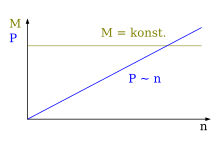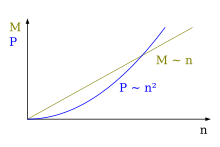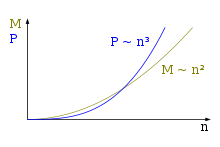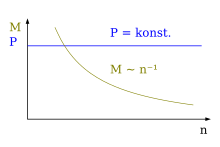Load moment
In drive technology, the load torque or counter-torque is the torque that a driven machine opposes the driving motor. The load torque is made up of the moment of inertia of the moving parts, the friction and the load. In order to overcome the load torque, the driving motor must be dimensioned in such a way that it applies a torque that is above the counter torque of the driven machine during the entire run-up phase.
Basics
The starting behavior of a drive is determined by the torque developed by the motor and the counter torques of the machine to be driven. Depending on the difference between these two torques, the driving machine can use the existing acceleration torque to reach the nominal speed. The greater the acceleration torque, the shorter the start-up time, that is, the faster the motor reaches its nominal speed. The level of the load torque has an influence on the selection and use of the required starting method . When operating with changing speed, the load torque is specified as a function of the speed (load torque characteristic). The load torque determining the drive can also be higher than that during operation at constant speed, if a speed range with a higher torque has to be passed through, or if the vehicle is to be approached quickly, i.e. accelerated quickly. The acceleration torque depends on the moment of inertia of the driven machine and the prime mover and on the specified start-up time.
Load torque as a function of speed: load torque characteristics
A distinction is made between the following four basic dependencies:
- Constant load torque
- Load torque increasing linearly
- Load torque increasing quadratically
- Load torque decreasing linearly reciprocally
Source:
Constant load torque
The load torque is constant over the entire speed range.
The required power increases proportionally with the speed .
This load moment applies to machine tools at constant cutting speed, conveyor belts , cranes , rolling mills , hoists , winches and extruders.
Load torque increasing linearly
The load torque increases proportionally with the speed.
The required drive power grows quadratically with the speed.
This load moment is typical for calenders (for processing paper, textiles or rubber foils), eddy current brakes , frequency converters , generators (due to speed-proportional friction).
Load torque increasing quadratically
The load torque increases with the square of the speed.
The required power increases with the third power of the speed.
Whenever fluid or air resistance has to be overcome, these relationships are relevant. Machines with a load torque that increases by the square of the square are fans , centrifugal pumps , compressors , and centrifuges .
Load torque decreasing linearly reciprocally
The load torque falls linearly reciprocally to the speed.
The required drive power remains constant.
Typical work machines with this behavior are turning and winding machines .
Drive design
The drive machines for work machines are diverse. The most common prime movers today are internal combustion and electric motors. When dimensioning the drive, the load torque characteristic of the driven machine is chosen as a planning basis for the selection of the driving motor. The torque delivered by the motor is just sufficient if the motor characteristic intersects the load torque characteristic of the driven machine at the operating point. One of these motors can only be designed with the aid of the load torque characteristic of the driven machine, if a long start-up time can be accepted. The drive machine is sufficiently dimensioned if its torque characteristic intersects with the load torque characteristic at the operating point of the driven machine (exception when starting up “under load”, the starting torque is higher than the operating torque and when the load characteristic is falling). The rule of thumb for electric motors is that their output torque should be around 20% higher than the load torque of the driven machine. If a quick run-up is necessary, the acceleration torque must be determined and added to the load torque.
See also
literature
- Andreas Kremser: Electrical machines and drives, fundamentals, motors and applications. 2nd edition, Teubner Verlag, Stuttgart, 2004, ISBN 3-519-16188-5
- HR Risg: Electrical engineering for the practitioner. 1st edition, Verlag Elektrotechnik Walter Liechti, Aarau (Switzerland) 1990, ISBN 3-905214-11-3
Individual evidence
- ↑ a b Federal Office for Economic Issues (Ed.): Drive technology in mechanical engineering . Ravel, Bern 1995, pp. 25-28.
- ↑ a b ABB Automation Group Ltd (Ed.): Speed-controlled drives . Technical Instructions 4, Mannheim 2000, pp. 16-18, 30.
- ↑ a b Rockwell Automation (Ed.): Starting Motors . Basics for practice, p. 2.2.
- ↑ a b c d e f g Franz Moeller, Paul Vaske (Ed.): Electrical machines and converters. Part 1 structure, mode of operation and operating behavior, 11th revised edition, BG Teubner, Stuttgart 1970, pp. 19-23.
- ↑ a b c Helmut Greiner: Starting, braking, positioning with three-phase motors . Danfoss GmbH, Online (accessed July 25, 2016) pp. 20, 23, 60–63, 68–69, 74, 76, 82.
- ^ A b c d e Hans-Jürgen Bederke, Robert Ptassek, Georg Rothenbach, Paul Vaske: Electrical Drives and Controls 2nd revised edition, BG Teubner, Stuttgart 1975, pp. 11-17.
Web links
- Characteristic curves of motors and machines (accessed on July 21, 2016)











